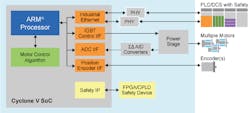It’s not just our familiarity with Ethernet or its ability to more easily connect the plant floor to the enterprise that will continue to drive the rise of Ethernet on the plant floor. Embedded systems will also play a role.
Drive-on-chip systems, for example, use FPGAs (field programmable gate arrays) to place the control algorithm elements of industrial drives into various types of automation hardware. Because these embedded drive systems can be easily programmed — or reprogrammed — they can support multiple types of encoders and industrial Ethernet protocols.
Granted, this drive-on-chip concept is of higher interest to automation OEMs than it is to end users; but having a degree of knowledge about how this embedded technology will shape the automation devices you buy and use in the near future should be a priority for end users as well.
Altera, manufacturer of the Cyclone V and Cyclone V SoC (system on chip) FPGAs, contends that, as automation vendors work to integrate their digital drive functions onto a single piece of silicon, the communication protocol is, by necessity, becoming a small function implemented as part of the entire "drive-on-chip" design. And when you consider that a drive system vendor must support six to eight standards to be able to sell its products worldwide, it’s not difficult to see why the flexible drive-on-chip will become popular with device manufacturers.
Currently, to support a particular industrial Ethernet protocol, an OEM must design the Ethernet MAC (media access control) for its industrial products that often differs from a traditional Ethernet MAC, which requires a special design in the FPGA or ASIC. As a result, different real-time requirements for the end device can lead to different architectures of the communication protocol standards. Plus, as Ethernet protocol standards continue to evolve, there is always a possibility that the MAC design may change.
For OEMs to future-proof their designs to cope with such changes once their devices are in place at a manufacturing facility, Altera contends that a programmable hardware approach is the safest bet.
Implementing the Industrial Ethernet protocol as an embedded function within a programmable fabric, according to Altera, gives OEMs the flexibility to support multiple protocols with the same hardware as well as the ability to create an integrated system design factoring in power, cost, and form factor.
Since FPGAs are now capable of performing simple interface logic and bridging functions in addition to embedded processing functions, traditional FPGA functions can be integrated with the drive control loop and communication protocol functions. In essence, this boils down to industrial Ethernet being just one of the blocks integrated in an FPGA along with other common functions.
Altera will be presenting at The Automation Conference (May 14-15, 2013) in Chicago to help automation vendors and users better understand how advances in embedded systems are changing the landscape of automation hardware and software. Also, Altera has produced a white paper covering this topic in detail. You can access the white paper here.

